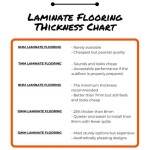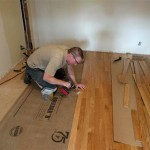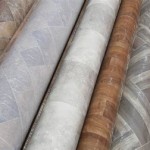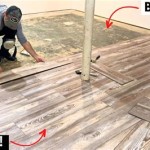Installing Vinyl Plank Flooring Over OSB Board: A Comprehensive Guide
Oriented strand board (OSB) is a common structural panel often used as a subfloor in residential and commercial construction. Its affordability and strength make it a popular choice. Vinyl plank flooring, known for its durability, water resistance, and ease of installation, is also a frequent selection for homeowners seeking a cost-effective and aesthetically pleasing flooring solution. Combining these two materials raises the question: Can you install vinyl plank flooring directly over OSB board? The short answer is yes, but successful installation hinges on several crucial considerations to avoid potential problems down the line.
The suitability of OSB as a subfloor for vinyl plank flooring depends primarily on the OSB's condition, thickness, and the type of vinyl plank being installed. Imperfections in the OSB, such as unevenness, gaps, or protruding fasteners, can telegraph through to the vinyl plank surface, affecting its appearance and potentially compromising its integrity. Furthermore, moisture content in the OSB is a significant factor, as excessive moisture can lead to warping, swelling, and ultimately, failure of the vinyl plank installation. Therefore, careful preparation and adherence to best practices are paramount.
Before embarking on the installation process, it’s essential to determine the type of vinyl plank flooring being used. There are generally two main types: glue-down and click-lock (also known as floating) vinyl plank. Glue-down vinyl planks require a perfectly smooth and stable surface for proper adhesion, making the preparation of the OSB subfloor even more critical. Click-lock vinyl planks, on the other hand, offer some flexibility and can tolerate minor imperfections in the subfloor, but they still require a level and structurally sound base.
Assessing the OSB Subfloor's Condition
The initial step in determining the feasibility of installing vinyl plank flooring over OSB is a thorough inspection of the subfloor. This assessment should encompass several key factors. First, check for any signs of water damage, such as stains, discoloration, or mold growth. Moisture can significantly degrade the OSB's structural integrity and create an environment conducive to mold and mildew, which can undermine the flooring installation. If water damage is present, the affected areas must be repaired or replaced before proceeding.
Second, examine the OSB surface for any unevenness, such as raised seams, dips, or gouges. These imperfections can create pressure points on the vinyl plank flooring, leading to premature wear and tear or even breakage. A long, straight edge or level should be used to identify and quantify any deviations in the surface. Significant unevenness will need to be addressed, typically by filling low spots with a leveling compound or sanding down high spots.
Third, inspect the OSB for any loose or protruding fasteners, such as nails or screws. These fasteners can damage the vinyl plank flooring or prevent it from lying flat. All fasteners should be countersunk below the surface of the OSB and any loose fasteners should be replaced or tightened. Finally, check for any large gaps between the OSB sheets. Gaps exceeding the manufacturer's recommendations should be filled with a suitable patching compound to provide a continuous and stable surface.
Preparing the OSB Subfloor for Vinyl Plank Installation
Once the OSB subfloor has been thoroughly assessed, the next step is to prepare it for the vinyl plank installation. The specific preparation methods will vary depending on the condition of the OSB and the type of vinyl plank flooring being used, but some general guidelines apply. The first step is always to clean the OSB surface thoroughly. This can be done by sweeping, vacuuming, and then wiping it down with a damp cloth to remove any dust, dirt, or debris. This ensures proper adhesion for glue-down vinyl planks and prevents debris from interfering with the locking mechanisms of click-lock planks.
After cleaning, any imperfections identified during the assessment phase must be addressed. Small holes or gouges can be filled with a patching compound designed for wood substrates. For larger areas of unevenness, a self-leveling underlayment may be necessary. A self-leveling underlayment is a cement-based compound that is poured over the OSB and allowed to spread evenly, creating a smooth and level surface. This is particularly important for glue-down vinyl plank installations, as it provides the necessary surface for proper adhesion.
In some cases, an underlayment may be recommended even if the OSB surface is relatively smooth. An underlayment can provide additional cushioning, reduce noise transmission, and improve the overall comfort of the flooring. When selecting an underlayment, it's crucial to choose one that is compatible with both the OSB subfloor and the vinyl plank flooring. The underlayment should also be moisture-resistant to protect the OSB from moisture penetration.
Finally, it's essential to ensure that the OSB subfloor is properly acclimated to the environment before installing the vinyl plank flooring. Vinyl plank flooring is susceptible to expansion and contraction due to temperature and humidity changes. Allowing the OSB and the vinyl plank flooring to acclimate to the room's temperature and humidity levels for at least 48 hours prior to installation can minimize these effects and prevent problems such as buckling or gapping after installation.
Addressing Moisture Concerns in OSB Subfloors
Moisture is a primary enemy of OSB and a major concern when installing any type of flooring, including vinyl plank. OSB is highly susceptible to moisture absorption, which can cause it to swell, warp, and delaminate. High moisture levels can also create a breeding ground for mold and mildew, leading to unpleasant odors and potential health problems. Therefore, addressing moisture concerns is critical before installing vinyl plank flooring over OSB.
The first step in addressing moisture concerns is to measure the moisture content of the OSB subfloor. This can be done using a moisture meter, which provides a reading of the percentage of moisture in the wood. The ideal moisture content for OSB before installing vinyl plank flooring is typically between 8% and 12%, but it's crucial to consult the vinyl plank manufacturer's recommendations for specific guidelines. If the moisture content is above the recommended level, it's necessary to identify and address the source of the moisture.
Potential sources of moisture include leaks from plumbing fixtures, condensation from HVAC systems, and inadequate ventilation in crawl spaces or basements. Repairing any leaks and improving ventilation can help to reduce moisture levels in the OSB. In some cases, a dehumidifier may be necessary to remove excess moisture from the air. Applying a moisture barrier to the OSB subfloor can also help to protect it from moisture penetration. A moisture barrier is a thin layer of plastic or other waterproof material that is installed between the OSB and the vinyl plank flooring. This barrier prevents moisture from seeping into the OSB and causing damage.
It is crucial to remember that installing vinyl plank flooring over OSB that has a high moisture content can lead to significant problems down the road. The vinyl plank flooring may not adhere properly, and the OSB may warp or swell, causing the flooring to buckle or come loose. Mold and mildew growth can also occur, leading to health problems and potentially requiring costly remediation. Therefore, taking the time to address moisture concerns before installing vinyl plank flooring is essential for a successful and long-lasting installation.
In addition to these practical considerations, you should always consult the specific installation guidelines provided by both the OSB manufacturer and the vinyl plank flooring manufacturer. These guidelines can provide valuable information about compatibility, proper installation techniques, and warranty requirements. Adhering to these guidelines can help to ensure a successful and trouble-free installation.
Finally, if there are any doubts about the suitability of the OSB subfloor for vinyl plank flooring, it's always best to consult with a qualified flooring contractor. A professional contractor can assess the condition of the OSB, provide expert advice on the proper preparation methods, and ensure that the vinyl plank flooring is installed correctly. This can help to avoid costly mistakes and ensure a beautiful and long-lasting flooring installation.

How To Install Glue Down Luxury Vinyl Plank Flooring On Osb Sub Floor

Can You Install Hardwood Flooring Over Osb Board 2 Factors

How To Prep Wood Subfloor For Luxury Vinyl Plank Flooring Beginners Fix High And Low Spots
Can Vinyl Flooring Be Installed Over A Plywood Subfloor

Can You Install Hardwood Flooring Over Osb Board 2 Factors

How To Level A Plywood Or Osb Subfloor Using Asphalt Shingles Construction Felt

Choosing Subfloor For Hardwood Tile And Laminate Floors

Complete Guide Underlayment For Vinyl Sheet Flooring

Plywood Vs Osb Subflooring The Pros And Cons Of Each Bob Vila

How To Lay A Wooden Osb Board Floor In The Attic
Related Posts








